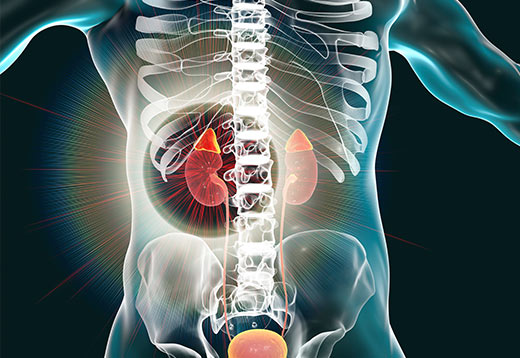The ovaries secrete female hormones, ovarian tumors divided into benign and malignant, the later do not express themselves clearly, which may delay their diagnosis and thus may affect the cure rate. Most of the symptoms of ovarian cancer are similar to those of other diseases.
Thank you for reading this post, don't forget to subscribe!Initial signs of ovarian cancer:
- Abdominal bloating or changes in the nature of defecation and urination.
- Anorexia.
- Unintentional weight loss.
- Fatigue.
- Pain in the pelvis or back.
A genetic mutation turns the normal cells of the ovary into abnormal cells that are present in the ovary . It grows and multiplies at an out-of-control rate and leads to an internal mass and then invades nearby tissues, and then it can move to distant places in the body if diagnosis and treatment is delayed.
There are several types of ovarian cancer, the most famous of which is epithelial ovarian tumors , which occur in adults and the elderly The least known of these is germ cell tumors , which occur mostly in children and adolescents.
There are many factors that increase the risk of ovarian cancer:
- Old age
- Excess weight and obesity cause hormonal imbalance
- Starting menstruation at an early age – before 12 y or stopping it at a later age increases the risk of endometrial cancer. The more menstrual cycles you have
- Having a family history of patients.
- Genetic factors such as BRCA 1 BRCA 2 and Lynch syndrome.
- A family history of ovarian cancer.
- Uncontrolled use of hormones to treat menopausal symptoms
- Not being pregnant increases the risk of compared to being pregnant even once.
To reduce the risk of ovarian cancer:
- Recognize the risks of hormone therapy to control menopausal symptoms.
- Taking oral contraceptives for at least one year may reduce The possibility of uterine cancer.
- Exercising and maintaining an ideal weight.
- Genetic analysis, especially if there is a breast or ovarian tumor in the family under the age of 50.
To diagnose ovarian cancer, the patient undergoes:
- Clinical examination of the pelvis and abdomen
- Ultrasound.
- CT.
- MRI.
- PET CT.
- Tumor markers such as CA 125 , HE4 , B-HCG and AFP and LDH and CEA .
In most cases, a sample is not taken before surgery, and the patient may need to take a sample in cases of large tumors that need drug treatment before surgery.
Recent scientific studies have proven the important role of chemotherapy in the treatment of ovarian cancer. The treatment is used Medication before an operation to reduce the size of a large cancer so that it is easier to remove it with surgery and to improve the rate of cure. . It is possible to use them after surgery, depending on the stage of the tumor.
Ovarian cancer operations include:
- Excision of the cyst only with certain requirments.
- Unilateral salpingo-oopherectomy with tumor resection, in young patients seeking fertility with certain requirements.
- Pan hystrectomy.
Peritoneal fluid analysis of the abdomen, pelvis, abdominal tissue and pelvic lymph nodes are performed in all types of ovarian cancer surgeries to accurately determine the stage of the cancer and thus complete the treatment plan
Here comes the role of minimally invasive surgical intervention using advanced laparoscopy in resecting the uterus without the traditional large incision.
It has several advantages, including: The amount of blood loss during surgery is less and there is less pain ، compared to conventional surgery . In addition, the chances of surgical complications are less and less need for analgesics and blood transfusions after surgery , thus helping patients return to their normal lives faster compared to other surgeries.
The patient does not need a long stay in the hospital, so he can be discharged from the hospital one day after the surgery in most of cases. .
The role of periodic follow-up comes with detection and imaging every 3 to 6 months for the first two years and then every 6 to 12 months thereafter based on international scientific guidelines to complete the treatment plan.




